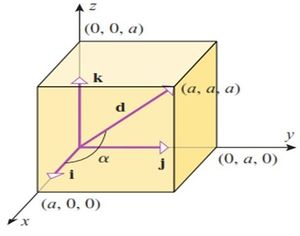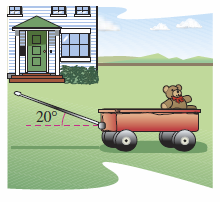Calculus III Advanced (Course) (11.3) (Homework)
Contents
- 1 Section 11.3 Homework
- 1.1 Exercise 11.3.4 Finding Dot Products
- 1.2 Exercise 11.3.10 Finding the Angle Between Two Vectors
- 1.3 Exercise 11.3.14 Finding the Angle Between Two Vectors
- 1.4 Exercise 11.3.42 Finding the Projection for \( \textbf{u} \) onto \( \textbf{v} \)
- 1.5 Exercise 11.3.57 Finding an Angle
- 1.6 Exercise 11.3.62 Work
- 2 Internal Links
Section 11.3 Homework
From Calculus 10e by Larson and Edwards, p. 773. Exercises 4, 10, 14, 42, 57, 62.
Exercise 11.3.4 Finding Dot Products
Find
(a) \( \textbf{u} \cdot \textbf{v}\)
(b) \( \textbf{u} \cdot \textbf{u}\)
(c) \( \| \textbf{u} \|^{2} \)
(d) \( (\textbf{u} \cdot \textbf{v})\textbf{v}\)
(e) \( \textbf{u} \cdot 2(\textbf{v})\)
where \(\textbf{u}=\langle -4,8 \rangle, \: \textbf{v}=\langle 7,5 \rangle\)
Solution
(a) \( \textbf{u} \cdot \textbf{v} = (-4)(7)+(8)(5) = -28 + 40 = 12\)
(b) \( \textbf{u} \cdot \textbf{u} = (-4)(-4)+(8)(8) = 16 + 64 = 80\)
(c) \( \| \textbf{u} \|^{2} = \textbf{u} \cdot \textbf{v} = \langle -4,8 \rangle \cdot \langle -4,8 \rangle= (-4)(-4)+(8)(8) = 16 + 64 = 80 \)
(d) \( (\textbf{u} \cdot \textbf{v})\textbf{v} = 12 \langle 7,5 \rangle = \langle 84,60 \rangle\)
(e) \( \textbf{u} \cdot 2(\textbf{v})= 2(\textbf{u} \cdot \textbf{v}) = 2(12) = 24\)
Exercise 11.3.10 Finding the Angle Between Two Vectors
Find the angle \(\theta\) between the vectors (a) in radians and (b) in degrees, where \( \textbf{u} = \langle 3,1 \rangle\), and \( \textbf{v} = \langle 2,-1 \rangle\).
Solution
- $$ \cos \theta = \frac{5}{\sqrt{10} \sqrt{5}} = \frac{5}{\sqrt{50}} = \frac{1}{\sqrt{2}} = \frac{\sqrt{2}}{2}$$
(a) \( \frac{\pi}{4} \) radians
(b) 45° degrees
Exercise 11.3.14 Finding the Angle Between Two Vectors
Find the angle \(\theta\) between the vectors (a) in radians and (b) in degrees, where \( \textbf{u}= 3\textbf{i} + 2\textbf{j}+\textbf{k}\) and \( \textbf{v}= 2\textbf{i} - 3\textbf{j}\).
Solution Because \( \textbf{u}= \langle 3,2,1 \rangle \) and \( \textbf{v}= \langle 2,-3,0 \rangle \).
- $$ \cos \theta = \frac{0}{\sqrt{14}\sqrt{13}} = 0 $$
(a) 0 radians
(b) 0° degrees
Exercise 11.3.42 Finding the Projection for \( \textbf{u} \) onto \( \textbf{v} \)
For (a) find the projection for \( \textbf{u} \) onto \( \textbf{v} \), and (b) find the vector component for \( \textbf{u} \) orthogonal to \( \textbf{v} \) where, \( \textbf{u}= \textbf{i} + 4\textbf{k}\) and \( \textbf{v}= 3\textbf{i} + 2\textbf{k}\).
Solution
- $$\textbf{(a) } \frac{11}{13}(3\textbf{i} + 2\textbf{k})= \frac{33}{13}\textbf{i} + \frac{22}{13}\textbf{k}$$
- $$\textbf{(b) } \textbf{w}_{2}=\textbf{u}-\textbf{w}_{1}= (\textbf{i} + 4\textbf{k}) - \left (\frac{33}{13}\textbf{i} + \frac{22}{13}\textbf{k} \right ) =\frac{20}{13}\textbf{i}+\frac{30}{13}\textbf{k} $$
Exercise 11.3.57 Finding an Angle
|
|
Find the angle between a cube’s diagonal and one of its edges.
|
Exercise 11.3.62 Work
|
|
A toy wagon is pulled by exerting a force of 25 pounds on a handle that makes a 20° angle with the horizontal, as shown in Figure 11.3.13. Find the work done in pulling the wagon 50 feet.
|
Internal Links
Parent Article: Calculus III Advanced (Course)

